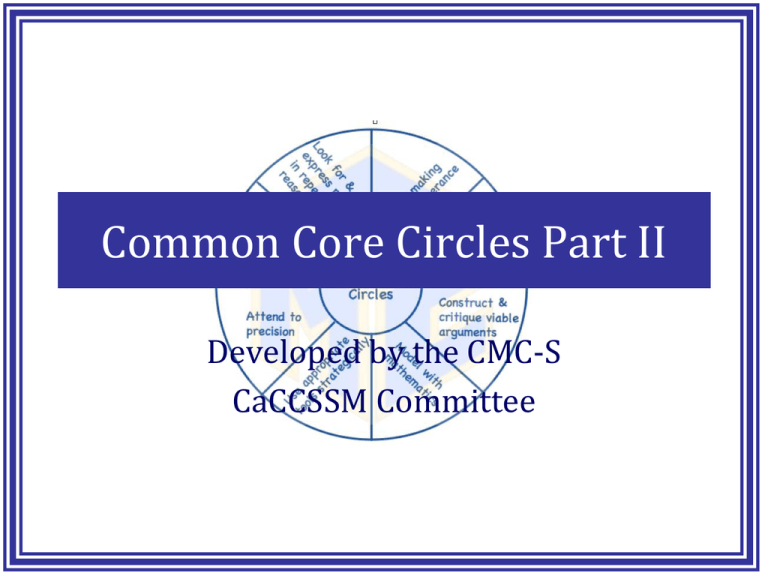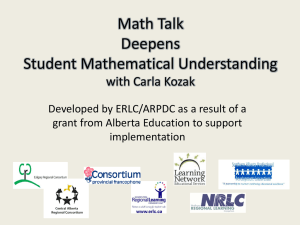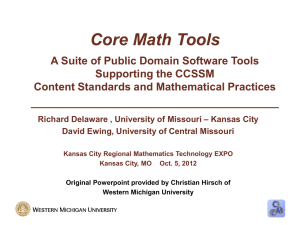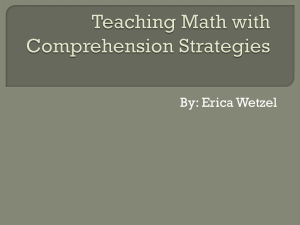Common Core Circles PD - CMC-S
advertisement

Common Core Circles Part II Developed by the CMC-S CaCCSSM Committee Outcomes • Participants will – Learn how to facilitate student thinking and discourse around common core mathematics standards. – Learn how to implement such tasks within their classrooms. – Plan for how to implement such tasks within your classroom, site and/or district. 2 What is a Common Core Math Circle? • Inspired by Math Circles – Student Math Circles • A social context for students to explore math – Teacher Math Circles • A social context for teachers to explore math and its pedagogy. • Common Core Math Circles – A social context for teachers to explore Common Core Math Standards and related pedagogy. http://www.mathteacherscircle.org/news.html 3 The Goal of Common Core Circles • To increase teachers’ – mathematical knowledge – use of interactive, student-centered problem solving – belief in their own mathematical ability. – belief in their students’ mathematical ability. – understanding of Common Core Standards 4 To Multiply or Not? • Instructions: – Solve the task as an adult learner. – Once you have solved it, solve it another way. – Then solve it in another way… 5 Instructions • Some of the situations on your handout can be represented by 1/8 x 2/5, while others need a different operation. Select the situations that can be represented by multiplying these two numbers. For the remaining, tell what operation is appropriate. In every case, justify your thinking. 6 Share Solutions • Share with others in your group. • Facilitators will select representative solutions to share with the whole group. 7 Make Connections • At your table, discuss the following: • What were the key mathematical ideas within the task? • What mathematics did you use to solve the problem? • How does what you did compare to the solutions presented? 8 The Mathematics • • • • • Claims Domains/Conceptual Categories Standards for Mathematical Practice Grade Level Content Standards Depth of Knowledge 9 Leaves and Caterpillars • “A fourth-grade class needs five leaves each day to feed its 2 caterpillars. How many leaves would the students need each day for 12 caterpillars?" • Use drawings, words, or numbers to show how you got your answer. • Try to do this problem in as many ways as you can, both correctly and incorrectly. You may work with a partner. 10 Orchestrating Productive Mathematics Discussions • Mathematical discussions are a key part of effective mathematics teaching – To encourage student construction of mathematical ideas – To make students’ thinking public so it can be guided in mathematically sound directions – To learn mathematical discourse practices 11 The Case of David Crane • Read the handout, "Leaves and Caterpillars: The Case of David Crane" • As you read the vignette, identify: – Aspects of Mr. Crane's instruction you would want him to see as promising. – Aspects on which you want to help him. Smith, Margaret & Stein, Mary Kay; 5 Practices for Orchestrating Productive Mathematics Discussion; NCTM, 2011. 12 David Crane: What is Promising? • Students are working on a mathematical task that appears to be both appropriate and worthwhile • Students are encouraged to provide explanations and use strategies that make sense to them • Students are working with partners and publicly sharing their solutions and strategies with peers • Students’ ideas appear to be respected 13 David Crane: What Can Be Improved? • Beyond having students use different strategies, Mr. Crane’s goal for the lesson is not clear. • Mr. Crane observes students as they work, but does not use this time to assess what students seem to understand or identify which aspects of students’ work to feature in the discussion in order to make a mathematical point. • There is a “show and tell” feel to the presentations. 14 Conclusion • The Case of David Crane illustrates the need for guidance in shaping classroom discussions and maximizing their potential to extend students’ thinking and connect it to important mathematical ideas. • What follows is a guide based on five doable instructional practices, for orchestrating and managing productive classroom discussions. 15 The Five Practices Model What to do in the classroom with the task. NCTM Seminar: Effective Mathematics Instruction: The Role of Mathematical Tasks; Peg Smith University of Pittsburg The Five Practices are: 1. Anticipating student responses to challenging mathematical tasks; 2. Monitoring students‘ work on and engagement with the tasks; 3. Selecting particular students to present their mathematical work; 4. Sequencing the student responses that will be displayed in a specific order and 5. Connecting different students’ responses and connecting the responses to key mathematical ideas 17 Step 0 (We were kidding about 5) • Select a task that mirrors the mathematics you want students to learn and is in a context which students understand. 1. Anticipating likely student responses to selected tasks • Involves considering: • All possible strategies for working the selected task. • Supported by: • Working the task in as many ways as possible • Teacher created observation form 19 20 2. Monitoring Students’ actual responses during independent work • Involves: • Circulating while students work, watching and listening • Recording interpretations, strategies, and points of confusion • Asking probing questions to get students back “on track” or to advance their understanding (no telling!) • Supported by: • Using recording tools 21 3. Selecting Student responses to feature during discussion •Involves: • Choosing students to present because of the mathematics in their responses • Making sure that over time all students are seen as authors of mathematical ideas and have the opportunity to demonstrate competence • Gaining some control over the content of the discussion (no more “who wants to present next”) 22 4. Sequencing Student responses during the discussion. • Involves: • Purposefully ordering presentations so the mathematics is accessible to all students • Building a mathematically coherent story line from prior knowledge to current grade level standards. 23 5. Connecting Student responses during the discussion – How does comparing different solutions within and across grade levels deepen your understanding of Common Core teaching and learning • Involves: • Encouraging students to make mathematical connections between different student responses through questioning • Making the key mathematical ideas that are the focus of the lesson salient • Considering extensions as they come from the students or the teacher. 24 Why The Five Practices Help: • Provide teachers with more control over the learning through • the discussed content • thoughtful teaching moves: not always improvising • Provides teachers with more time to • diagnose students’ thinking • plan questions and other instructional moves • Provides a reliable process for teachers to gradually improve their lessons over time 25 Why These Five Practices Help: • Honor students’ thinking while guiding it in productive, disciplinary directions • Support students’ disciplinary authority while simultaneously holding them accountable to discipline • Guidance mostly ‘under the radar’ so not impinging on students’ growing mathematical authority • Students are led to identify problems with their approaches, better understand sophisticated ones, and make mathematical generalizations 26 (Ball, 1993; Engle & Conant, 2002) Planning Time • Plan for how to implement such tasks within your classroom, site and/or district • Be prepared to share your ideas within your group and with the whole group 27 Resources Related to the Five Practices • • • • • • • Smith, M.S., Hughes, E.K., & Engle, R.A., & Stein, M.K. (2009). Orchestrating discussions. Mathematics Teaching in the Middle School, 14 (9), 549-556. Stein, M.K., Engle, R.A., Smith, M.S., & Hughes, E.K. (2008).Orchestrating productive mathematical discussions: Helping teachers learn to better incorporate student thinking. Mathematical Thinking and Learning, 10, 313-340. Smith, M.S., & Stein, M.K. (in press). Orchestrating Mathematical Discussions. National Council of Teachers of Mathematics. Smith, Margaret & Stein, Mary Kay; 5 Practices for Orchestrating Productive Mathematics Discussion; NCTM, 2011. NCTM Seminar: Effective Mathematics Instruction: The Role of Mathematical Tasks; Peg Smith University of Pittsburg Annenberg Learner: www.learner.org/workshops/missinglink/pdf/tools3.pdf Source: Adapted from Connecticut Common Core of Learning, Mathematics Assessment Project. Sponsored by a grant from the National Science Foundation. 28 Web Site and email • cmc-south.org/caccssm.html • • • • commoncorecircles@gmail.com mfarber@laalliance.org barnold@ucsd.edu Jennifer.Montgomery@pomona.k12.ca.us On-line survey • General Instructions: – You will send your message to the phone number 37607 using the format picture on the next slide – The first five digits of your text message represents the session code. 44476 A single empty space follows – The next three digits represent your evaluation for three question, one digit for each question. A single empty space follows the third digit. • Q1: Speaker was well=prepared and knowledgeable (0,1,2,3) • Q2: Speaker was engaging and effective presenter (0,1,2,3) • Q3: Session matched title and description in program book (0,1,2,3) – Enter any comment you wish to make to the speaker 30 On-line survey 31






